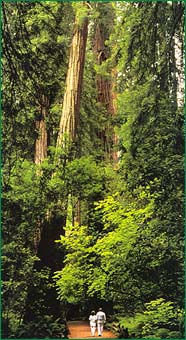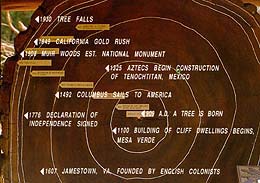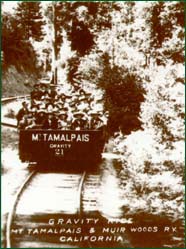

It is known that the Native Americans living in the area which later became Marin County were Miwoks. The Miwok were, for the most part, coastal dwellers. The largest centers of population were located near present-day Bolinas, Sausalito and San Rafael, because these areas put them close to a dependable food supply of clams, mussels, limpets and acorns. Most likely the Miwoks never lived in Muir Woods; however, it is probable that they did pass through the area and, on occasion, hunt in this vicinity.

Western man came upon the scene with the arrival of the Spanish missionaries in the mid 1700's. The Spanish practiced occasional logging to provide timbers for their ships and missions. Some grazing was done on coastal grasslands, and of course, crops were planted to provide the settlements with food. The most important legacy left by the Spanish on the environment of Marin County was their very great cultural influence which is still seen today, especially reflected in architectural themes.

In 1838, William Richardson received a Mexican grant of land, Rancho Saucelito (Little Willow Ranch), which contained all the Marin land southeast of Mt. Tamalpais, and included Redwood Canyon and the lands now within Muir Woods National Monument. The tranquil Spanish way of life was maintained until gold was discovered in California, at Sutter's Mill, in 1849. This caused a mass migration of those who hoped to make their fortunes in the gold fields. The password of the day became...get in, get rich quick, and get out. San Francisco became the center for this horde of humanity, and the tradition of leisured living came to an abrupt halt. Timber, meat and crops were now needed in much greater quantities. As a result black tail deer populations were reduced, and elk, antelope, grizzly and black bear, cougar and coyote disappeared completely. Most of the easily accessible timber in Marin County was logged between 1840 and 1870. Luckily Redwood Canyon escaped much of this onslaught because of its inaccessibility, and the extreme difficulty of logging such steep slopes.

Early visitors arrived on foot, on horseback, by buggy, and via the Mill Valley and Mt. Tamalpais Railroad, dubbed the "crookedest railroad in the world" because of the many twists and turns made by the tracks as they climbed Mt. Tamalpais. In 1908 the first automobile reached Muir Woods over the wagon road from Mill Valley. This early use of the Monument was quite casual as people wandered as they wished, and vehicles passed through the length of the canyon. Needless to say, such indiscriminate use caused severe damage to the understory (ground cover) vegetation, and eventually necessitated stronger regulatory measures. Cars were excluded from redwood groves in 1924, and the elimination of picnicking, the fencing of trails, and the prohibition of plant, animal and rock collecting soon followed. Also, small tracts of private land were added to the Monument to prevent incompatible land uses on contiguous lands.
Today Muir Woods stands as a reminder of the way much of the surrounding Marin County land once appeared. Here may be found an environment which can heighten our awareness of the gaps between "progress" of the 20th Century technology and the quality of our lives.